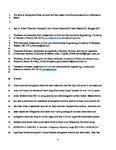The role of alongshore flows on inner surf and swash zone hydrodynamics on a dissipative beach
| dc.contributor.author | Puleo, JA | |
| dc.contributor.author | Cristaudo, D | |
| dc.contributor.author | Torres-Freyermuth, A | |
| dc.contributor.author | Masselink, Gerd | |
| dc.contributor.author | Shi, F | |
| dc.date.accessioned | 2020-05-26T10:38:34Z | |
| dc.date.available | 2020-05-26T10:38:34Z | |
| dc.date.issued | 2020-10-01 | |
| dc.identifier.issn | 0278-4343 | |
| dc.identifier.issn | 1873-6955 | |
| dc.identifier.other | 104134 | |
| dc.identifier.uri | http://hdl.handle.net/10026.1/15702 | |
| dc.description | 12 month embargo required | |
| dc.description.abstract |
Cross-shore and alongshore velocities were measured over five high tide cycles in the swash and inner surf zones of a dissipative beach (significant wave height between 0.5 and 1.65 m; water levels between 0 and 0.87 m) using acoustic and electromagnetic current meters. Measurements are used to determine the importance of alongshore motions relative to cross-shore motions for bed shear stress; a parameter required for many sediment transport formulations. Velocities and water depths are infragravity dominated with running average (5 min) cross-shore and alongshore velocities being of similar magnitude near 0.25 m/s. Significant coherence squared between cross-shore velocity and water depth is found in an infragravity frequency range (0.0078 Hz–0.024 Hz). A narrower infragravity frequency range (0.012 Hz–0.022 Hz) of significant coherence squared is found between alongshore velocity and water depth. Near bed velocity profiles at high spatial resolution indicate the mean profile of cross-shore or alongshore velocity for different relative cross-shore positions are nearly depth uniform, suggesting, on average, a well-mixed water column. Time-averaged onshore-directed depth-averaged velocities are nearly constant as a function of mean water depth, whereas time-averaged offshore-directed depth-averaged velocity magnitudes decrease with an increase in mean depth. In contrast, mean alongshore depth-averaged velocity magnitudes increase with depth regardless of the corresponding cross-shore motion and were always southerly-directed. These variations result from changes in breaking wave forcing location (i.e. relative cross-shore position). Near instantaneous velocity profile data are used to estimate friction coefficients and the bed shear stress through the Law of the Wall assumption. Mean friction coefficients for alongshore flows are similar to those obtained for cross-shore flows and values of ~0.02 are appropriate for all phases of flow. Alongshore bed shear stresses are the dominant bed shear stress component for over 27% of the samples implying an enhancement of total bed shear stress through incorporation of alongshore motions. Neglecting these alongshore processes (even if alongshore uniform) in cross-shore sediment transport models will lead to errors in predicted sediment transport rates. | |
| dc.format.extent | 104134-104134 | |
| dc.language | en | |
| dc.language.iso | en | |
| dc.publisher | Elsevier BV | |
| dc.subject | Swash zone | |
| dc.subject | Shear stress | |
| dc.subject | Velocity | |
| dc.subject | Foreshore | |
| dc.subject | Friction coefficients | |
| dc.subject | Logarithmic law | |
| dc.title | The role of alongshore flows on inner surf and swash zone hydrodynamics on a dissipative beach | |
| dc.type | journal-article | |
| dc.type | Journal Article | |
| plymouth.author-url | https://www.webofscience.com/api/gateway?GWVersion=2&SrcApp=PARTNER_APP&SrcAuth=LinksAMR&KeyUT=WOS:000535127900005&DestLinkType=FullRecord&DestApp=ALL_WOS&UsrCustomerID=11bb513d99f797142bcfeffcc58ea008 | |
| plymouth.volume | 201 | |
| plymouth.publication-status | Published | |
| plymouth.journal | Continental Shelf Research | |
| dc.identifier.doi | 10.1016/j.csr.2020.104134 | |
| plymouth.organisational-group | /Plymouth | |
| plymouth.organisational-group | /Plymouth/Faculty of Science and Engineering | |
| plymouth.organisational-group | /Plymouth/Faculty of Science and Engineering/School of Biological and Marine Sciences | |
| plymouth.organisational-group | /Plymouth/REF 2021 Researchers by UoA | |
| plymouth.organisational-group | /Plymouth/REF 2021 Researchers by UoA/UoA07 Earth Systems and Environmental Sciences | |
| plymouth.organisational-group | /Plymouth/Research Groups | |
| plymouth.organisational-group | /Plymouth/Research Groups/Marine Institute | |
| plymouth.organisational-group | /Plymouth/Users by role | |
| plymouth.organisational-group | /Plymouth/Users by role/Academics | |
| plymouth.organisational-group | /Plymouth/Users by role/Researchers in ResearchFish submission | |
| dcterms.dateAccepted | 2020-04-24 | |
| dc.rights.embargodate | 2021-4-30 | |
| dc.identifier.eissn | 1873-6955 | |
| dc.rights.embargoperiod | Not known | |
| rioxxterms.funder | Natural Environment Research Council | |
| rioxxterms.identifier.project | Turbulence, Sediment Stratification and Altered Resuspension under Waves (TSSAR Waves) | |
| rioxxterms.versionofrecord | 10.1016/j.csr.2020.104134 | |
| rioxxterms.licenseref.uri | http://www.rioxx.net/licenses/all-rights-reserved | |
| rioxxterms.licenseref.startdate | 2020-10-01 | |
| rioxxterms.type | Journal Article/Review | |
| plymouth.funder | Turbulence, Sediment Stratification and Altered Resuspension under Waves (TSSAR Waves)::Natural Environment Research Council |


